Abstract
AIM: To investigate the possibility that the incidence of apoptotic bodies in the cryptal epithelium might help to identify colonic lesions due to drugs, especially non-steroidal anti-inflammatory drugs (NSAIDs). METHODS: The apoptotic count (AC) the number of apoptotic bodies per 100 crypts was calculated in a series of colorectal biopsy specimens, stained with haematoxylin and eosin from patients with (a) known or suspected drug induced colitis and (b) inflammatory bowel disease before or after treatment with salazopyrine or corticosteroids. These specimens were compared with normal biopsy specimens from a control group of comparable age and sex distribution. RESULTS: Under normal conditions apoptotic bodies were seldom seen at all and the mean apoptotic count was less than 1.0. In untreated inflammatory bowel disease the mean apoptotic count was marginally increased (2.4), but when there was a partial response to drug treatment the apoptotic count rose to 13.1 (p 0.003). In colonic lesions directly attributable to drugs the apoptotic count was always increased, reaching its highest level (106) with 5-fluorouracil. In colitis related to NSAIDs apoptoses were associated with inflammation, most notably an increase in lymphocytes in both lamina propria and epithelium. CONCLUSION: The presence of crypt apoptoses in substantial numbers (with an apoptotic count in excess of 5) should always raise the possibility of drug effect. The mechanisms involved are not clear but with NSAIDs the changes might well be immunologically mediated.
Full text
PDF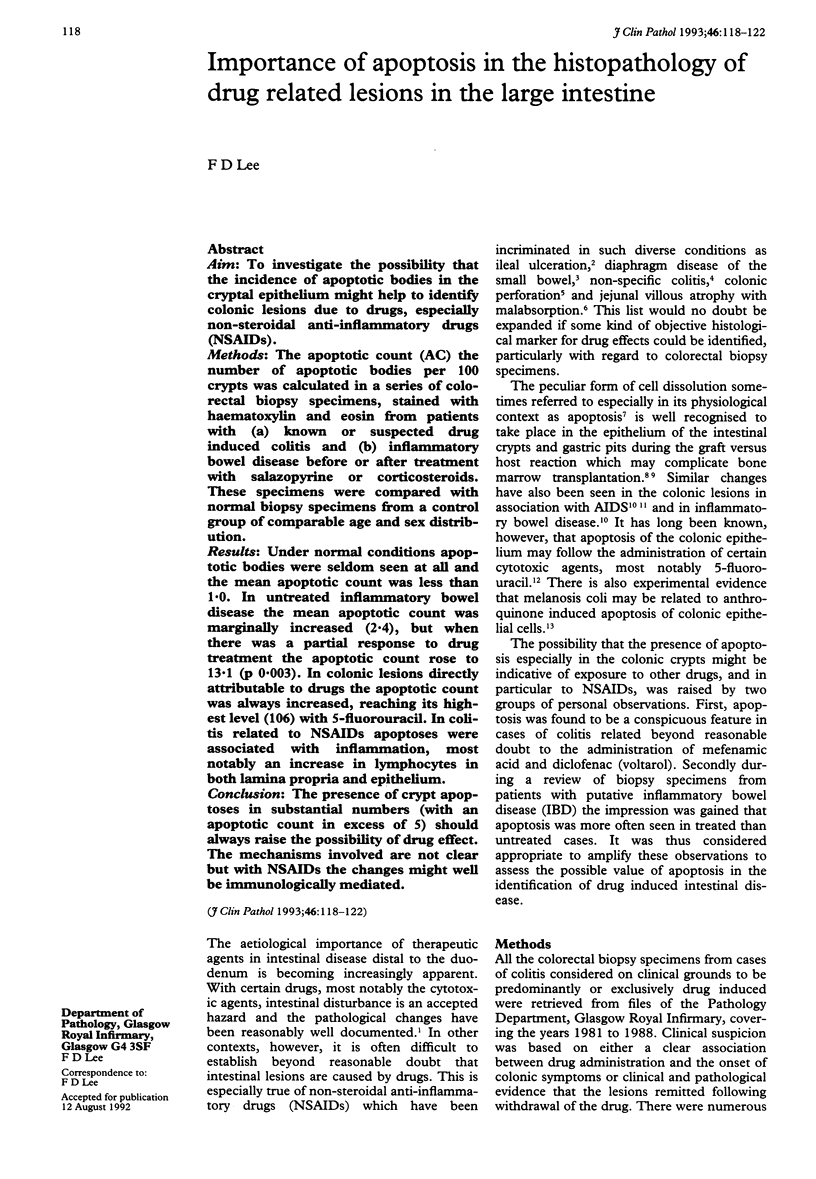
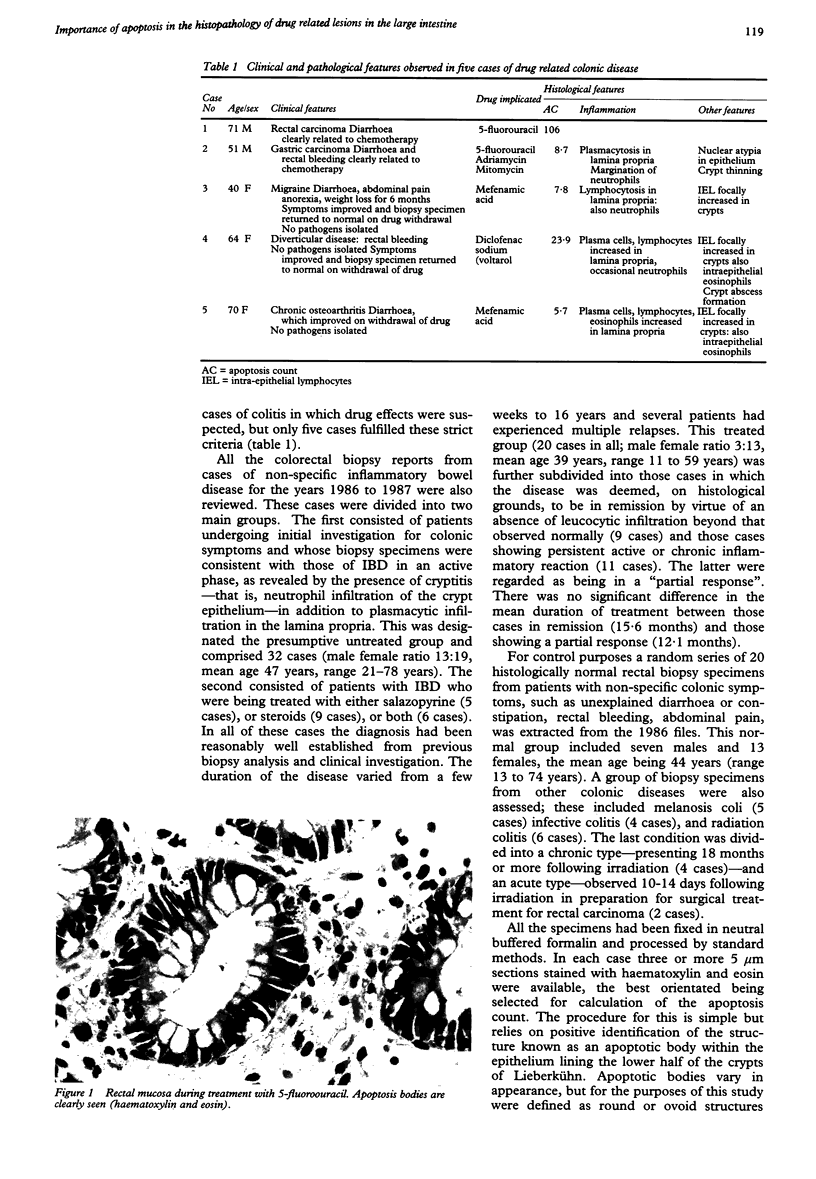
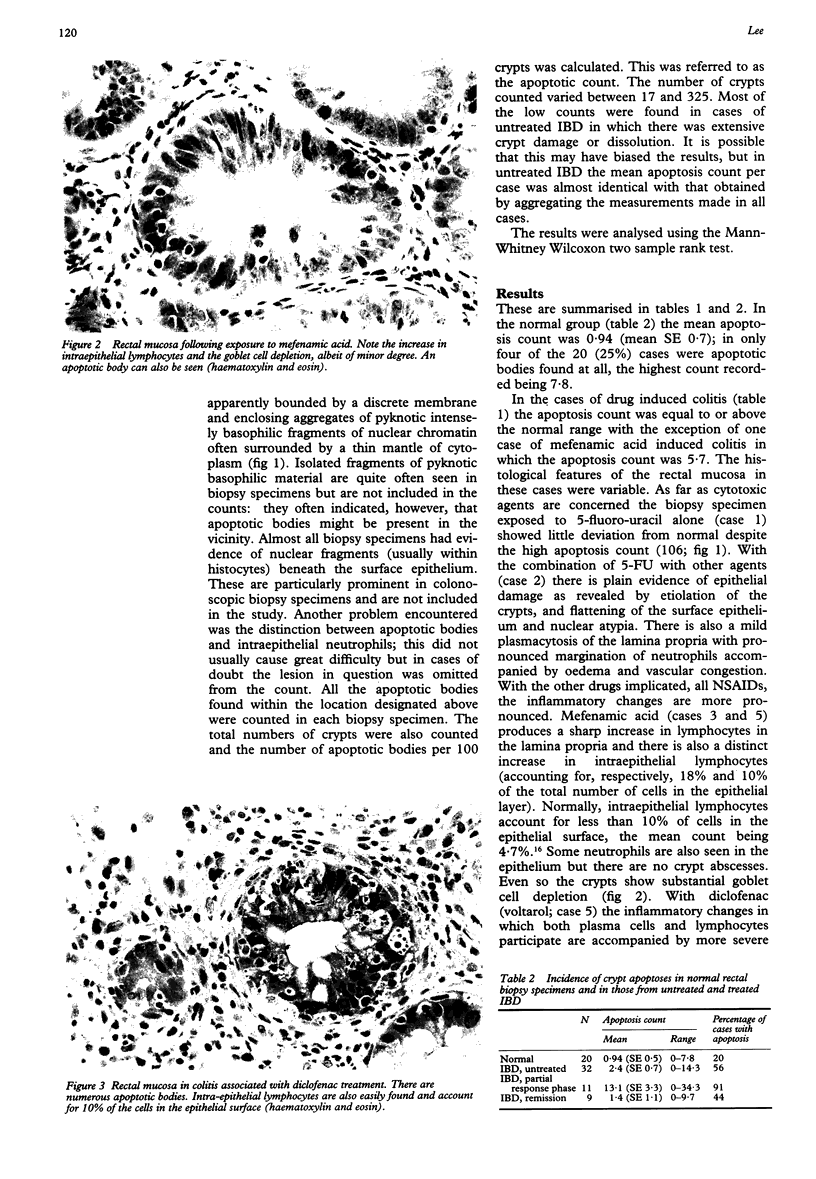
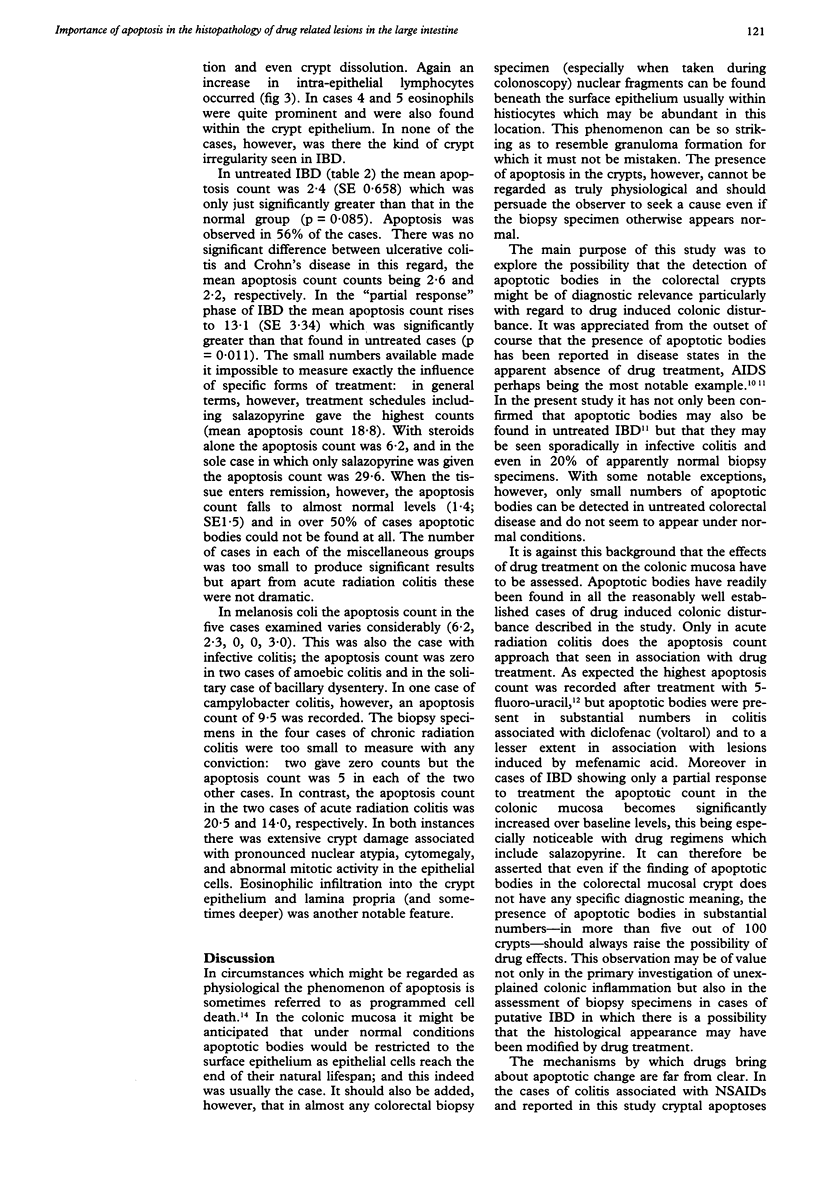
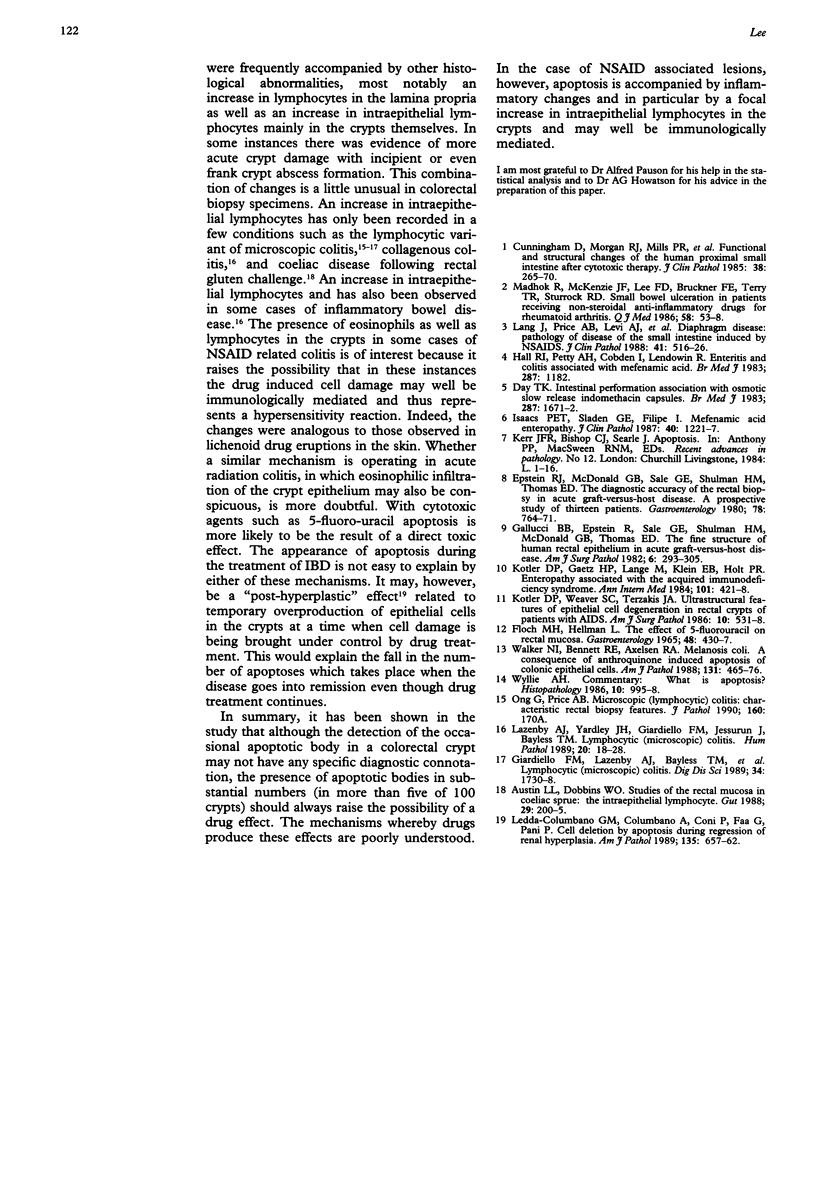
Images in this article
Selected References
These references are in PubMed. This may not be the complete list of references from this article.
- Austin L. L., Dobbins W. O. Studies of the rectal mucosa in coeliac sprue: the intraepithelial lymphocyte. Gut. 1988 Feb;29(2):200–205. doi: 10.1136/gut.29.2.200. [DOI] [PMC free article] [PubMed] [Google Scholar]
- Cunningham D., Morgan R. J., Mills P. R., Nelson L. M., Toner P. G., Soukop M., McArdle C. S., Russell R. I. Functional and structural changes of the human proximal small intestine after cytotoxic therapy. J Clin Pathol. 1985 Mar;38(3):265–270. doi: 10.1136/jcp.38.3.265. [DOI] [PMC free article] [PubMed] [Google Scholar]
- Day T. K. Intestinal perforation associated with osmotic slow release indomethacin capsules. Br Med J (Clin Res Ed) 1983 Dec 3;287(6406):1671–1672. doi: 10.1136/bmj.287.6406.1671-a. [DOI] [PMC free article] [PubMed] [Google Scholar]
- Epstein R. J., McDonald G. B., Sale G. E., Shulman H. M., Thomas E. D. The diagnostic accuracy of the rectal biopsy in acute graft-versus-host disease: a prospective study of thirteen patients. Gastroenterology. 1980 Apr;78(4):764–771. [PubMed] [Google Scholar]
- FLOCH M. H., HELLMAN L. THE EFFECT OF FIVE-FLUOROURACIL ON RECTAL MUCOSA. Gastroenterology. 1965 Apr;48:430–437. [PubMed] [Google Scholar]
- Gallucci B. B., Sale G. E., McDonald G. B., Epstein R., Shulman H. M., Thomas E. D. The fine structure of human rectal epithelium in acute graft-versus-host disease. Am J Surg Pathol. 1982 Jun;6(4):293–305. doi: 10.1097/00000478-198206000-00002. [DOI] [PubMed] [Google Scholar]
- Giardiello F. M., Lazenby A. J., Bayless T. M., Levine E. J., Bias W. B., Ladenson P. W., Hutcheon D. F., Derevjanik N. L., Yardley J. H. Lymphocytic (microscopic) colitis. Clinicopathologic study of 18 patients and comparison to collagenous colitis. Dig Dis Sci. 1989 Nov;34(11):1730–1738. doi: 10.1007/BF01540051. [DOI] [PubMed] [Google Scholar]
- Hall R. I., Petty A. H., Cobden I., Lendrum R. Enteritis and colitis associated with mefenamic acid. Br Med J (Clin Res Ed) 1983 Oct 22;287(6400):1182–1182. doi: 10.1136/bmj.287.6400.1182. [DOI] [PMC free article] [PubMed] [Google Scholar]
- Isaacs P. E., Sladen G. E., Filipe I. Mefenamic acid enteropathy. J Clin Pathol. 1987 Oct;40(10):1221–1227. doi: 10.1136/jcp.40.10.1221. [DOI] [PMC free article] [PubMed] [Google Scholar]
- Kotler D. P., Gaetz H. P., Lange M., Klein E. B., Holt P. R. Enteropathy associated with the acquired immunodeficiency syndrome. Ann Intern Med. 1984 Oct;101(4):421–428. doi: 10.7326/0003-4819-101-4-421. [DOI] [PubMed] [Google Scholar]
- Kotler D. P., Weaver S. C., Terzakis J. A. Ultrastructural features of epithelial cell degeneration in rectal crypts of patients with AIDS. Am J Surg Pathol. 1986 Aug;10(8):531–538. doi: 10.1097/00000478-198608000-00002. [DOI] [PubMed] [Google Scholar]
- Lang J., Price A. B., Levi A. J., Burke M., Gumpel J. M., Bjarnason I. Diaphragm disease: pathology of disease of the small intestine induced by non-steroidal anti-inflammatory drugs. J Clin Pathol. 1988 May;41(5):516–526. doi: 10.1136/jcp.41.5.516. [DOI] [PMC free article] [PubMed] [Google Scholar]
- Lazenby A. J., Yardley J. H., Giardiello F. M., Jessurun J., Bayless T. M. Lymphocytic ("microscopic") colitis: a comparative histopathologic study with particular reference to collagenous colitis. Hum Pathol. 1989 Jan;20(1):18–28. doi: 10.1016/0046-8177(89)90198-6. [DOI] [PubMed] [Google Scholar]
- Ledda-Columbano G. M., Columbano A., Coni P., Faa G., Pani P. Cell deletion by apoptosis during regression of renal hyperplasia. Am J Pathol. 1989 Oct;135(4):657–662. [PMC free article] [PubMed] [Google Scholar]
- Madhok R., MacKenzie J. A., Lee F. D., Bruckner F. E., Terry T. R., Sturrock R. D. Small bowel ulceration in patients receiving non-steroidal anti-inflammatory drugs for rheumatoid arthritis. Q J Med. 1986 Jan;58(225):53–58. [PubMed] [Google Scholar]
- Walker N. I., Bennett R. E., Axelsen R. A. Melanosis coli. A consequence of anthraquinone-induced apoptosis of colonic epithelial cells. Am J Pathol. 1988 Jun;131(3):465–476. [PMC free article] [PubMed] [Google Scholar]
- Wyllie A. H. What is apoptosis? Histopathology. 1986 Sep;10(9):995–998. [PubMed] [Google Scholar]





